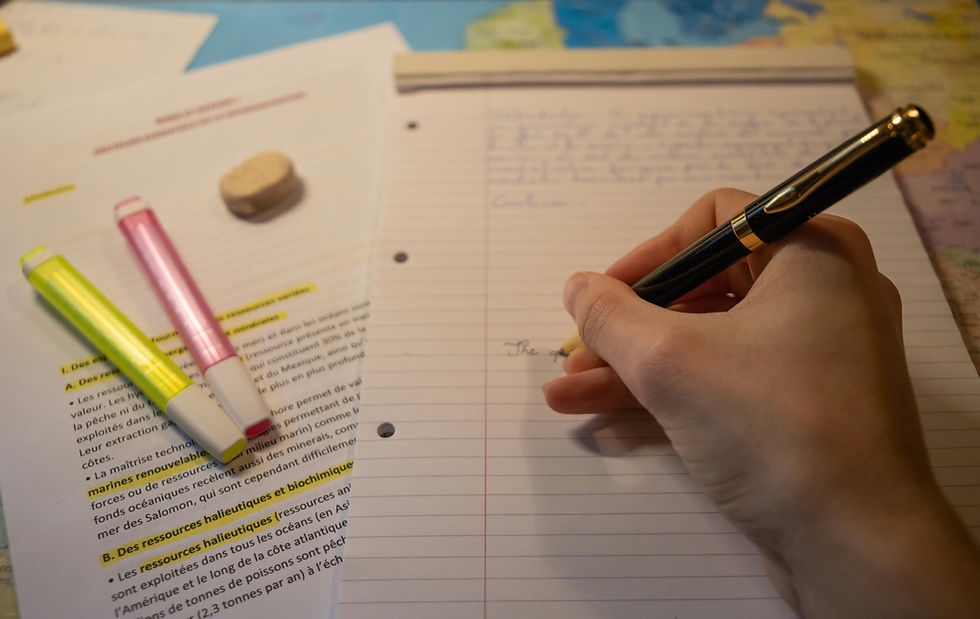Crafting is Chaos: Drafting and Editing
- ddillenback
- Sep 1, 2023
- 3 min read

It’s easy to mistake bad editing for bad writing. Editing is a different skill set often neglected after high school. When a teacher stops reviewing drafts, students begin to procrastinate and turn in the first paper that meets length requirements, maybe after an outline and spell-check.
Editing turns mediocre writing into good or even excellent writing, but only if weighted equally in importance. That’s why editors are paid more than writers and are almost always full-time employees. Luckily, editing is a trainable skill, and practice truly makes progress.
What does editing do for you?
Editing is freedom. It relieves the pressure of writing perfectly in the moment and allows you to let go and just write. Writing without editing is like assembling a puzzle with only one piece at a time. Drafting is putting all the pieces on the table and organizing them by color. Does this sentence make sense? Who cares! Move to the next, or try a few more versions. Too wordy? Don’t worry! You’ll cut it later. Can’t articulate the thought you want? Don’t freeze! Just write whatever crazy half-thoughts come to mind and return to it later.
Drafting Techniques: Creating something worth editing.
The sh--ty first draft. When I draft, I spew out my thoughts. I ride the wave of an idea until it breaks, then pivot to something else. It’s not quite train-of-thought, but certainly controlled chaos. I move past grammatical mistakes, ignore spelling errors, and push through thoughts even if the writing is garbage. Some people sit down and write anything for a set amount of time. This staves off writer’s block by removing the need for your writing to be good.
Assembling a piece. I distance myself from the work for a while before printing the draft and highlighting thoughts I still like. I organize these ideas into a cohesive structure by pasting them directly onto a new document. This is technically an outline, but an English teacher would cringe. I create a Frankenstein mix of sentence fragments and complete paragraphs without worrying about grammar. It sometimes helps to draw a diagram on a blank sheet of paper, showing how the ideas connect. I finally start to correct grammar and connect the thoughts with transitions until I have what looks like a finished paper. This feels like the end, but it’s the beginning of the editing process.

Editing Techniques: Creating something worth reading.
Move backward. Editing your work is difficult because you can’t approach it with fresh eyes. You know what you “mean” when you say things. Starting at the end of the document and working backward helps separate you from your work and look at one sentence at a time.
So what (the reverse outline). Distill every paragraph into a short sentence. Depending on your writing style, this may not be your topic sentence. If you can’t distill what a paragraph does for your piece, it may not be helping at all! Maybe it’s time to cut it.
Cut whole ideas. If I’m way above my word count, but cutting has slowed to a crawl, a complete idea may have to go. Find your weakest argument, evidence, or image and remove it altogether. One straightforward idea is more compelling than two vague ones.
Rinse and repeat. I’ll iterate on this process until I have a final product. I print and mark drafts with a pencil before returning to the computer to make the changes. Repeating this process until I’m within my word count and know the piece does what I want it to. Personally, this means making edits on the computer, printing, and marking up in pencil.
The 10% Rule. It’s not always necessary, but it’s an excellent final polish for your work. Cut until there is no way you could cut another word. Distance yourself…again. Return to the document and cut it by 10%.
Good writing is rarely done in a single sitting. The key is writing with passion and editing with discipline.
A Peak Behind the Curtain.
Target length: 600-700 words
First Draft: 1115 words
First Edit: 1095
Second Edit: 965
Third Edit: 842
Fourth Edit: 772
Fifth Edit: 739
Sixth Edit: 697
Final Post: 664








Comments